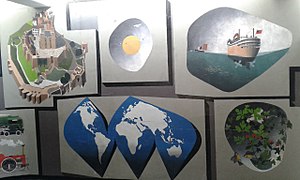Gordon Cullen
Thomas Gordon Cullen (9 August 1914 – 11 August 1994) was an influential British architect and urban designer who was a key motivator in the Townscape movement. Cullen presented a new theory and methodology for urban visual analysis and design based on the psychology of perception, such as the human need for visual stimulation and the notions of time and space.[1] He is best known for the book Townscape, first published in 1961.[2] Later editions of Townscape were published under the title The Concise Townscape.[3]
Life
This section needs additional citations for verification. (February 2014) |
Early life and education
Cullen was born in
Career

Between 1944 and 1946 he worked in the planning office of the Development and Welfare Department in
Illustrations
His techniques consisted largely of sketchy drawings that conveyed a particularly clear understanding of his ideas, and these had a considerable influence on subsequent architectural illustration styles. He also illustrated several books by other various authors, before writing his own book - based on the idea of Townscape - in 1961. The Concise Townscape has been republished around 15 times, proving to be one of the most popular books on Urban Design in the 20th Century.
Consultancy work
In 1956, Cullen became a freelance writer and consultant and, in the years immediately following he advised the cities of
Price & Cullen
For a while Cullen teamed up with a student, David Price, and they formed an architectural firm together - Price & Cullen. They won a competition in London in the 1980s and together designed and oversaw the building of the Swedish Quays housing development in Docklands. They worked together until 1990 as Price's first child was born and because Cullen's health was deteriorating. Price died in 2009 at the age of 53.
Death and legacy
Cullen lived in the small village of Wraysbury (Berkshire) from 1958 until his death, aged 80, on 11 August 1994, following a serious stroke. After his passing, David Gosling and Norman Foster collected various examples of his work and put them together in the book "Visions of Urban Design".
Awards
In 1972 he was elected Honorary Fellow of the
See also
- Townscape
- LDDC
- Reg Ward
- Modern Architecture
References
- ^ Caves, R. W. (2004). Encyclopedia of the City. Routledge. p. 156.
- ^ "Library of Congress LCCN Permalink 61016682". Lccn.loc.gov. Retrieved 3 February 2018.
- ^ "Library of Congress LCCN Permalink 73161799". Archived from the original on 10 July 2012.
- ^ "Our School". Archived from the original on 25 September 2015. Retrieved 24 September 2015.
- ^ "11 Gordon Cullen, Ceramic Tile Mural, 1958 — The Twentieth Century Society". C20society.org.uk. Retrieved 3 February 2018.
- Sources
- David Gosling and Foster Norman. Gordon Cullen: Visions of Urban Design. Academy Editions, 1996. ISBN 1-85490-435-3
- Gordon Cullen. Townscape. Reinhold Pub. Corp., 1961. LC control #3 .C8
- Gordon Cullen. The Concise Townscape. ISBN 0-7506-2018-8
Gallery
-
Partial view of the mural at Greenside School

